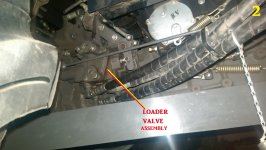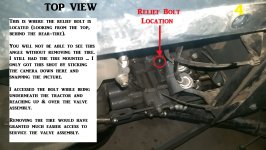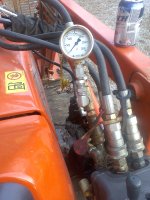TSO
Elite Member
Finally located the pressure-relief valve for my Massey 1648. This should be the same valve-assembly for multiple tractors built by Iseki (for Iseki, Massey, Challenger, etc). Once located, I was finally able to check my relief PSI. My pressure was set at 2350psi, which was low - the manual states the loader relief is rated/tested at 2500psi.
Once I finally located this valve, adjustment was relatively easy. Access is the main opponent, as it is hidden pretty tightly in there. Also, the lock-nut (see pics) was seized to the bolt with factory paint, so the whole bolt needed to be removed to "un-seize" that lock-nut before I could adjust the set-screw.
I am excited to test the loader now with my salt-pallet test. Adjusting to proper specs amounted to a 6% boost in hydraulic pressure going to the loader, which in the case of my previous salt test (51 bags = 2,040 lbs) should increase the lift by 122lbs (up to 54 bags) --- IF there is a direct 1:1 correlation between the % of PSI and the units of weight that it can lift. But I'm not versed in the mathematics of hydraulic theory, so I don't know if that will be the case. I have also been hearing people suggest that it is "safe" to go 10% above the "rated" spec, which would put me at 2750psi ... so I might play with it a bit to find out what happens. I would assume that as long as I stay safely below 3000psi, which my hoses are rated to, I shouldn't break anything ... for limited testing scenarios. Anyhow..............
See pics for a "how-to"





Once I finally located this valve, adjustment was relatively easy. Access is the main opponent, as it is hidden pretty tightly in there. Also, the lock-nut (see pics) was seized to the bolt with factory paint, so the whole bolt needed to be removed to "un-seize" that lock-nut before I could adjust the set-screw.
I am excited to test the loader now with my salt-pallet test. Adjusting to proper specs amounted to a 6% boost in hydraulic pressure going to the loader, which in the case of my previous salt test (51 bags = 2,040 lbs) should increase the lift by 122lbs (up to 54 bags) --- IF there is a direct 1:1 correlation between the % of PSI and the units of weight that it can lift. But I'm not versed in the mathematics of hydraulic theory, so I don't know if that will be the case. I have also been hearing people suggest that it is "safe" to go 10% above the "rated" spec, which would put me at 2750psi ... so I might play with it a bit to find out what happens. I would assume that as long as I stay safely below 3000psi, which my hoses are rated to, I shouldn't break anything ... for limited testing scenarios. Anyhow..............
See pics for a "how-to"





